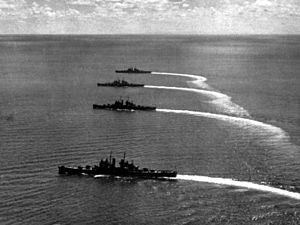Date 6 March 1943 | Result U.S. victory | |
 | ||
Similar Battle off Horaniu, World War II, Battle of Kula Gulf, Battle of Cape St George, Naval Battle of Vella Lav | ||
Battle of blackett strait
The Battle of Blackett Strait (Japanese: ビラ・スタンモーア夜戦 Battle of Vila-Stanmore) was a naval battle of the Pacific campaign of World War II, fought on 6 March 1943 in the Blackett Strait, between Kolombangara islands and Arundel Island in the Solomon Islands.
Contents
Background
After the American victory in the Guadalcanal campaign, operations in the Solomon Islands shifted to the west, where the Japanese maintained a substantial garrison on Kolombangara. On the night of 5 March 1943, the Japanese destroyers Murasame and Minegumo—commanded by Sho-sa (Lieutenant Commander) Yōji Tanegashima—took supplies to the Japanese base at Vila, on Kolombangara.
Battle
As they withdrew after landing their cargo, the two Japanese ships encountered Task Force 68 (TF 68), consisting of three light cruisers (USS Montpelier, Cleveland, and Denver) and three destroyers (USS Conway, Cony, and Waller) commanded by Rear Admiral Aaron S. Merrill, that had been bombarding Japanese positions at Vila.
In a short battle, both Japanese destroyers were sunk. Fifty-three survivors from Murasame and 122 survivors from Minegumo managed to reach Japanese lines. Two other survivors from Minegumo were later captured by U.S. forces.
Aftermath
On 7 May, the minelayers USS Gamble, Breese, and Preble laid mines across Blackett Strait in an attempt to interdict Japanese ship movements traveling through the strait. The next day, Japanese destroyers Oyashio, Kagero, and Kuroshio all hit mines in that area. Kuroshio sank immediately. Kagero and Oyashio sank later that day after being attacked and further damaged by U.S. aircraft from Henderson Field.
PT-109
Another engagement occurred in Blackett Strait when a force of 15 PT boats, including LTJG John F. Kennedy's PT-109 were sent to intercept the "Tokyo Express" supply convoy on 2 August. In what National Geographic called a "poorly planned and badly coordinated" attack, 15 boats with 60 available torpedoes went into action. However, of the 30 torpedoes fired by PT boats from four sections, not a single hit was scored.
In the battle, only four PT boats (the section leaders) had radar, and they were ordered to return to base after firing their torpedoes on radar bearings. When they left, the remaining boats were virtually blind and without verbal orders, thus leading to more confusion.
Patrolling just after the section leader had departed for home, PT-109 was run down on a dark moonless night by the Japanese destroyer Amagiri, returning from the supply mission. The PT boat had her engines at idle to hide her wake from seaplanes. Conflicting statements have been made as to whether the destroyer captain spotted and steered towards the boat. Members of the destroyer crew believed the collision was not an accident, though other reports suggest Amagiri's captain never realized what happened till after the fact. The captain of PT-109 was future U.S. President John F. Kennedy. His crew was assumed lost by the U.S. Navy, but were found later by Solomon Islander scouts Biuku Gasa and Eroni Kumana in a dugout canoe.
